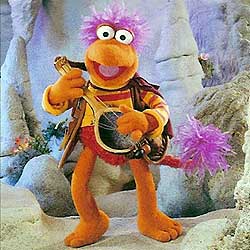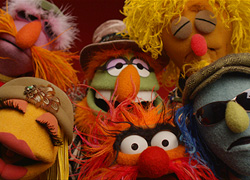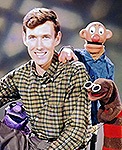Traveling Matt
Well-Known Member
- Joined
- Apr 14, 2002
- Messages
- 931
- Reaction score
- 6
I hope this doesn't affect future Fraggle volumes (or season sets) at any point down the line...
==========================================================
Apax buys HIT Entertainment for $934 Million
March 22, 2005
On March 21, 2005, HIT Entertainment Plc. agreed, to take a £489.4 million ($934 million) cash takeover offer from U.K. venture capitalists Apax Partners.
HIT, the kids entertainment company behind such characters at BOB THE BUILDER, THOMAS THE TANK ENGINE and BARNEY THEPURPLE DINOSAUR, made the announcement as it revealed disappointing financial results for the six months ending Jan. 31.
“We believe this offer is in the best interests of shareholders and provides an attractive cash premium to today’s share price,” said HIT chief exec Charles Burdick. “These interim results reflect the continued impact of a weak U.S. dollar, issues with major retailers and weakness in the critical consumer licensing and home entertainment markets which has been particularly pronounced in the United States. Whilst these issues were flagged in our recent trading statement, improved second half results will be dependent on the success of our video release schedule and the launch of the linear service of our U.S. cable channel joint venture in September.”
Burdick was referring to a U.S. digital kids’ channel in partnership with Comcast, PBS and Sesame Workshops.
“Operationally, we are focused in the U.S. on revitalizing the Bob the Builder brand, which returned to PBS in January, and launching the U.S. cable channel later this year,” Burdick continued. “Creatively, we have five existing brands in production and are developing new series and brands which are expected to be introduced in the next two years. This is an attractive cash offer from Apax which values the company appropriately when you balance the difficult near term trading conditions with the strength of our portfolio of leading children’s brands. We believe it is in the best interests of all shareholders to accept this offer and the independent directors will recommend that they do so.”
Recently HIT founder/chairman Peter Orton led the company’s board to fire ceo Rob Lawes six months ago after disappointing results and replaced him with Burdick. Orton and Burdick will resign from the company and HIT will be de-listed off the London stock exchange.
Revenue fell over the past year from £92.8 million to £70.2 million and profit before tax dropped from £14.6 million to £2.9 million.
London-based Apax bid through accompany called Sunshine Acquisition. It will pay a 20% premium on HIT’s closing price March 18 on the London stock market.
Orton founded HIT 16 years ago with just $573.000 and took it public nine years ago. He now owns 6% of HIT and is reported to make about $30 million in the deal.
Established in 1989, HIT Ent. (www.hitentertainment.com) is one of the world’s leading preschool children’s entertainment producers and rights owners. With operations in the U.S., U.K., Canada, Japan and Germany, the company’s activities span television production and distribution, home entertainment, consumer products, publishing and live events. HIT's famous characters which include classic global brands such as BOB THE BUILDER, BARNEY, THOMAS & FRIENDS, PINGU, KIPPER and ANGELINA BALLERINA, which are enjoyed by children in more than 150 countries and territories.
==========================================================
Apax buys HIT Entertainment for $934 Million
March 22, 2005
On March 21, 2005, HIT Entertainment Plc. agreed, to take a £489.4 million ($934 million) cash takeover offer from U.K. venture capitalists Apax Partners.
HIT, the kids entertainment company behind such characters at BOB THE BUILDER, THOMAS THE TANK ENGINE and BARNEY THEPURPLE DINOSAUR, made the announcement as it revealed disappointing financial results for the six months ending Jan. 31.
“We believe this offer is in the best interests of shareholders and provides an attractive cash premium to today’s share price,” said HIT chief exec Charles Burdick. “These interim results reflect the continued impact of a weak U.S. dollar, issues with major retailers and weakness in the critical consumer licensing and home entertainment markets which has been particularly pronounced in the United States. Whilst these issues were flagged in our recent trading statement, improved second half results will be dependent on the success of our video release schedule and the launch of the linear service of our U.S. cable channel joint venture in September.”
Burdick was referring to a U.S. digital kids’ channel in partnership with Comcast, PBS and Sesame Workshops.
“Operationally, we are focused in the U.S. on revitalizing the Bob the Builder brand, which returned to PBS in January, and launching the U.S. cable channel later this year,” Burdick continued. “Creatively, we have five existing brands in production and are developing new series and brands which are expected to be introduced in the next two years. This is an attractive cash offer from Apax which values the company appropriately when you balance the difficult near term trading conditions with the strength of our portfolio of leading children’s brands. We believe it is in the best interests of all shareholders to accept this offer and the independent directors will recommend that they do so.”
Recently HIT founder/chairman Peter Orton led the company’s board to fire ceo Rob Lawes six months ago after disappointing results and replaced him with Burdick. Orton and Burdick will resign from the company and HIT will be de-listed off the London stock exchange.
Revenue fell over the past year from £92.8 million to £70.2 million and profit before tax dropped from £14.6 million to £2.9 million.
London-based Apax bid through accompany called Sunshine Acquisition. It will pay a 20% premium on HIT’s closing price March 18 on the London stock market.
Orton founded HIT 16 years ago with just $573.000 and took it public nine years ago. He now owns 6% of HIT and is reported to make about $30 million in the deal.
Established in 1989, HIT Ent. (www.hitentertainment.com) is one of the world’s leading preschool children’s entertainment producers and rights owners. With operations in the U.S., U.K., Canada, Japan and Germany, the company’s activities span television production and distribution, home entertainment, consumer products, publishing and live events. HIT's famous characters which include classic global brands such as BOB THE BUILDER, BARNEY, THOMAS & FRIENDS, PINGU, KIPPER and ANGELINA BALLERINA, which are enjoyed by children in more than 150 countries and territories.

 Welcome to the Muppet Central Forum!
Welcome to the Muppet Central Forum! Back to the Rock Season 2
Back to the Rock Season 2 Sesame Street Season 54
Sesame Street Season 54 The Muppets Mayhem premieres
The Muppets Mayhem premieres Bear arrives on Disney+
Bear arrives on Disney+ Sam and Friends Book
Sam and Friends Book